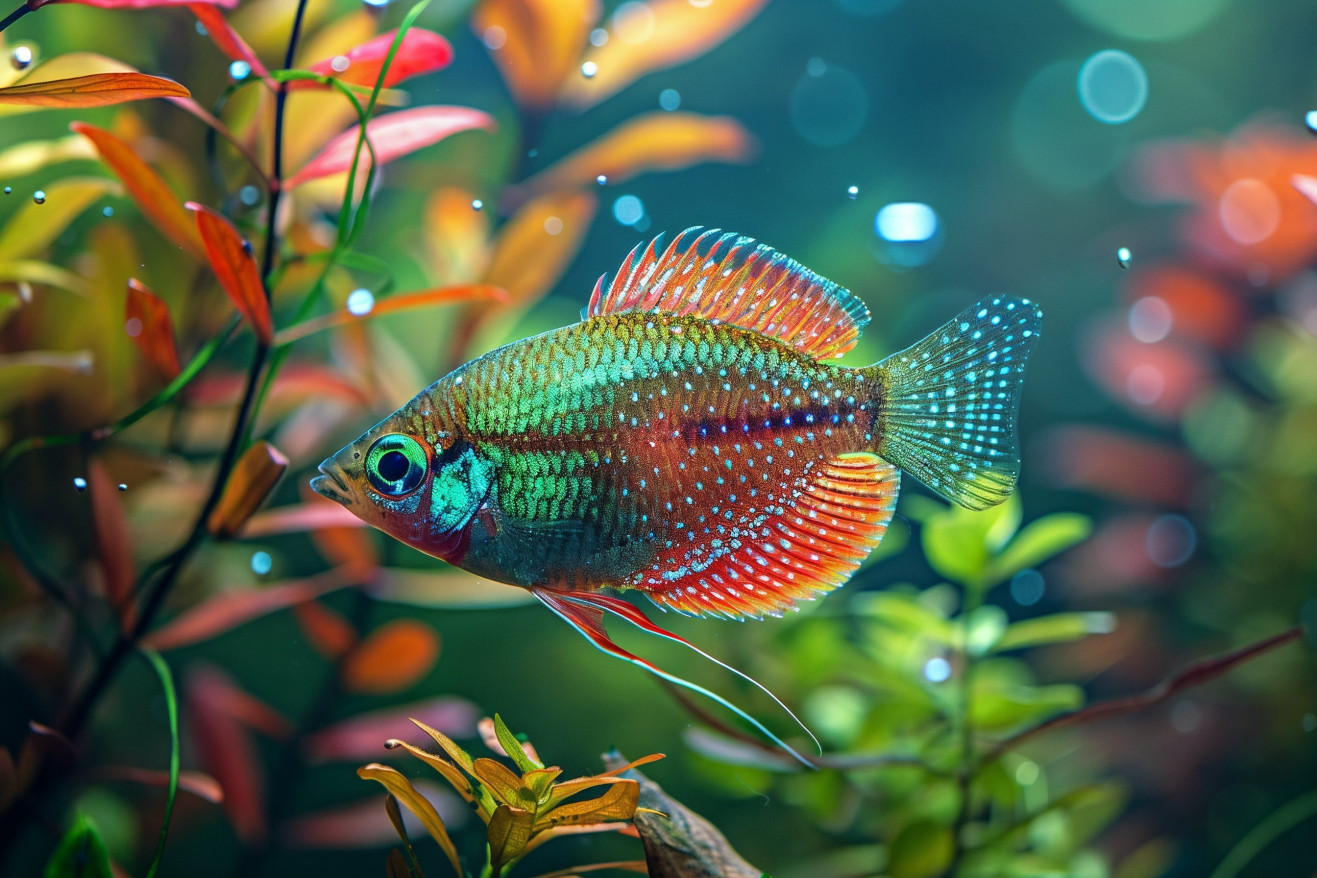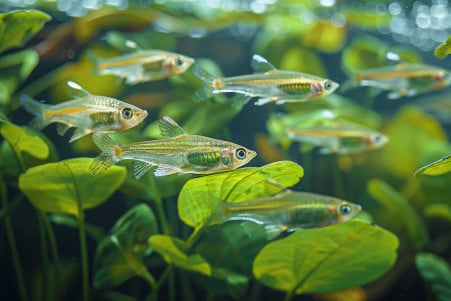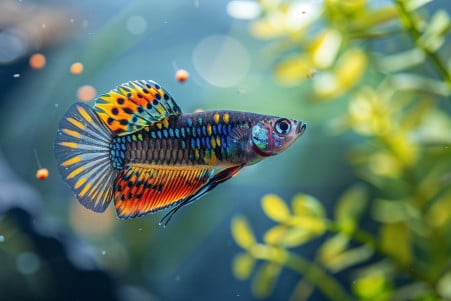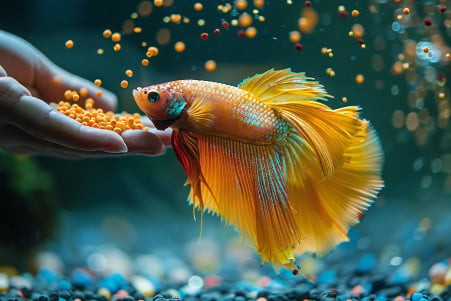What Do Small Fish Eat? Nutritional Requirements for Healthy Aquarium Fish
25 May 2024 • Updated 24 May 2024

When you're first setting up an aquarium and adding small fish, one of the most important things to know is what they eat in the wild so that you can make sure they're getting the right nutrients in your tank. Small freshwater fish like guppies, tetras, and rasboras are omnivores and eat a mix of algae, small crustaceans, and insect larvae in the wild, while small saltwater fish eat algae, plankton, and other small, microscopic creatures.
We'll use scientific studies from the fields of ichthyology and ecology to take a deep dive into the many different ways that popular small aquarium fish feed and what they like to eat. This will help you make sure you're offering a diet that's as close as possible to what they eat in the wild, so that they have the energy and nutrients they need to be healthy, colorful, and free from malnutrition.
What do small fish eat?
Feeding Freshwater Fish: Herbivores, Carnivores, and Omnivores
Freshwater fish can be divided into three main categories based on their natural diet: herbivores, carnivores, and omnivores. Herbivorous fish like some plecostomus species eat algae, aquatic plants, and vegetable matter. Carnivorous fish like clown loaches eat live or frozen foods such as brine shrimp, bloodworms, and small crustaceans. Omnivorous fish like barbs and gouramis need a mix of plant-based and meat-based foods to get the nutrients they need.
Making sure to feed fish the right types and amounts of food based on their category is important for their health and happiness in an aquarium. For example, mollies need a diet high in spirulina, while African cichlids need a mix of frozen and other foods. Knowing and replicating a fish's natural diet is important for keeping freshwater fish healthy and brightly colored in an aquarium. In addition, you can offer treats like fresh vegetables for herbivores or freeze-dried foods for carnivores to provide extra nutrients and stimulation.
How Often to Feed and How Much to Feed Small Fish
Smaller fish have faster metabolisms than larger fish, so they need to eat more often. Most fish can be fed once or twice daily, with some herbivorous fish requiring more frequent, smaller meals, according to The Spruce Pets. Overfeeding is a common problem that can lead to poor water quality and health problems for fish.
The Fishkeeper guide says to feed fish only as much food as they can eat in a few minutes, with no food left over. This will help minimize excess waste that can pollute the tank. The right amount of food and frequency of feeding will depend on the species and size of the fish. Algone's research shows that fast-growing fry and juveniles need to be fed more often and require a more specialized diet than adults, who can be fed a diet lower in protein.
It's important to monitor your fish's eating habits and adjust their feeding schedule as needed. Signs that you may be overfeeding or underfeeding your fish include fish that refuse to eat, fish that eat aggressively, and an accumulation of waste in the tank. Proper food storage to maintain the food's nutritional value is also important, so The Spruce Pets recommends buying food in small quantities and storing it in a cool, dry place.
Feeding Small Marine Fish: Imitating Natural Diets
Many small marine fish are carnivorous and need a high-protein diet that includes fish meal. The FAO reports that most marine fish species have a high protein requirement, and up to 70% of the total diet can be made up of protein in some starter feeds.
Common marine fish foods include brine shrimp, krill, marine flakes/pellets, mysis shrimp, phytoplankton, and seaweed. The Spruce Pets explains the benefits of these foods, pointing out that brine shrimp and krill are high in protein, while phytoplankton and seaweed contain essential amino and fatty acids.
Feeding attractants and specialized techniques may be required to stimulate feeding in some marine fish species. Advanced Aquarium Concepts explains that marine fish use their vision and chemoreceptors to find food, and certain nutritional feeding attractants can trigger a feeding response.
A combination of frozen, flake, and pellet foods will help ensure marine fish get a well-rounded nutritional profile. The FAO also explains that maintaining diet integrity and preventing the leaching of water-soluble nutrients is a major concern, especially for larval fish. Proper feeding practices, including feeding small amounts multiple times a day, are essential for the health of marine fish.
How to Feed a Mixed Aquarium
When keeping a mixed aquarium, it's important to consider the dietary needs and feeding behaviors of all the fish in the tank. One of the most important factors to keep in mind is the different zones that fish occupy within the tank.
Fish tend to occupy the top, middle, or bottom zones of the tank, and this can have a big impact on their feeding habits. Aqueon notes that herbivorous fish that are constantly foraging, such as mollies and plecostomus, are best suited for the middle and bottom zones because they can graze on the aquatic plants and algae in those areas. Meanwhile, carnivorous fish like clown loaches that hunt smaller prey are more likely to be found in the middle and bottom zones.
To make sure that all the fish in the tank are getting the food they need, it's important to offer a variety of different food types and feeding methods. The Gradex Company guide suggests that flakes are best for fish that feed at the surface, while pellets and wafers are better for fish that feed in the middle and bottom zones. By offering a mix of floating, sinking, and slow-dissolving foods, you can make sure that all the fish in the tank are getting the nutrition they require.
It's also important to consider the natural behaviors of the fish when it comes to feeding times and schedules. Natural Environment Aquatix suggests that mixed aquariums should be fed in the morning and evening because many of the fish that are being kept are nocturnal. By taking into account the natural feeding behaviors and preferences of the fish in the tank, you can make sure that all of your fish are getting the nutrition they need to stay healthy and thrive.
Live and Frozen Food Supplementation
In addition to dry foods, live and frozen foods can be used to supplement the diet of small fish. Reef Builders explains that live foods such as brine shrimp, daphnia, and blackworms are similar to the natural prey of many fish and can help encourage natural feeding behaviors. Meanwhile, frozen foods like krill, mysis shrimp, and fish eggs are a great way to ensure a varied and nutrient-dense diet, as noted by The Spruce Pets.
When adding live and frozen foods to a fish's diet, it's important to do so slowly and observe the fish's reaction. Bulk Reef Supply recommends using high-fat foods and alternating them with dry foods, adjusting the schedule as needed based on the species of fish. This ensures that small fish get a variety of nutrients.
However, while live and frozen foods can be beneficial, there are also some potential downsides. Aqueon warns that overfeeding or feeding fish the wrong type of food can lead to water quality issues and digestive problems in fish. As a result, it's important to make sure that these foods are fed in moderation and that they are stored properly.
Conclusion: How to Feed Small Fish a Balanced and Varied Diet
Herbivores tend to graze throughout the day, as it takes a lot more plant material to meet their nutritional needs than the meat protein carnivores consume. Aqueon says that omnivores are the most flexible, as they have the most options for acceptable food choices.
Carnivores eat less often, as they are less likely to catch food every day in the wild, and their feeding schedule in an aquarium should reflect that. Captain Experiences explains that many river fish are carnivorous, with a diet primarily consisting of smaller fish, worms, and crustaceans.
It's important to understand the natural diet of your fish and feed them accordingly. SeaWorld explains that bony fishes are a diverse group in terms of diet, with some being herbivores, some carnivores, and some omnivores. Smaller fish have a higher metabolic rate than larger fish of the same species, so they need to be fed more often.
To ensure that small fish get a balanced diet and all the nutrients they need, make sure to offer a variety of food, including flakes, pellets, live, and frozen foods. It's also important to monitor feeding practices and adjust them as needed to meet the needs of different fish species.


